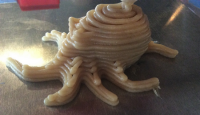Solid Freeform Fabrication (SFF) of food is one of the most talked about application for additive manufacturing technologies. Considering the concern around the safety issues on consuming 3D printed food various kinds of materials have been experimented upon. But one thing must be noted that these materials are not as same as the ones that are used for making food through traditional processes, like baking, frying, etc.
Researchers at the French Culinary Institute, New York have been demonstrating new materials that can be used for baking and frying. In the research they have found out that food items like, Turkey, celery (a kind of vegetable) and scallop (a type of sea-food) were processed and modified using transglutaminase (a type of enzyme) that makes the materials so that the printed food does not lose its shape when they are fried or baked.
However as we know that 3D Food Printing has been under strict scrutiny for some time as there are some limitations surrounding the possibilities of its progress.
1) The material requirements:
SFF or Food 3D Printing machines are still to be developed. So one needs to manually change the materials unlike the other 3D printing machines.
2) The acceptance of the materials used:
People are looking for breakthrough technologies that will complement current techniques. But the materials that are being used for 3D printing food needs to be compatible for conventional cooking methods too.
ADDITIVES USED:
Transglutaminase was proven to be a reliable additive agent that was used to hold the shape of any complex geometries out of meat.
In one experiment two candidate meats purees were chosen for testing materials. Turkeys were pureed with bacon fats added as purees. Making the two items pureed is a must as that will make them eligible for extrusion through the 3D printer. But adding transglutaminase before extruding allows the materials to retain its geometrical shape.
Instead the food was made on a 100% humid outer environment with the help of controlled vapour oven, where a water basin and air cavity are connected but they are bereft of temperature controls.In another experiment scallops, a very common shellfish consumed in the Western countries, was deep fried and the turkey was sous-vide Sous-vide is a process where the food is cooked at low temparture for a longer time and more often than not they are done in water. This helps to maintain the integrity of the materials used. One of the known ways to execute this kind of cooking is done in vacuum sealed bag of water. But a vacuum sealed bag of hot water will not be able to retain the geometry of a 3D Printed paste.
Another material that was proved to be beneficial for making 3D printed vegetables is Agre, derived from red algae. Surprisingly agar is used as a material as an alternative to gelatin for make desserts in eastern countries.
